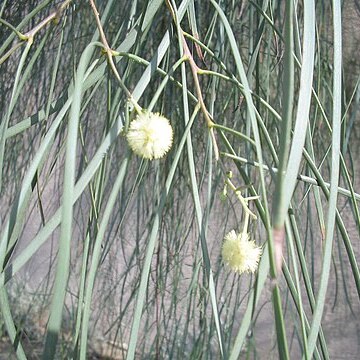Somewhat bushy tree 4–20 m high, with a tendency to sucker. Bark rough, dark grey to blackish. Branchlets normally pendulous, glabrous to sericeous. Phyllodes ligulate, pendulous, 15–40 cm long, 2–7 mm wide, innocuous with an acute to acuminate, often curved apex, coriaceous, rather lax, glabrous or sparsely appressed-puberulous, with numerous subdistant veins. Inflorescences (1–) 2–6-headed racemes; raceme axes (1–) 3–5 (–15) mm long, appressed-puberulous, rarely glabrous; peduncles 6–13 mm long, with indumentum as on raceme axes; heads globular, 6-9 mm diam., (20–) 25–40-flowered, creamy white to pale yellow. Flowers 5-merous; sepals ¾-united. Pods ±moniliform, breaking readily at constrictions, 10–26 cm long, (6–) 8–12 mm wide, woody, obscurely longitudinally wrinkled, glabrous. Seeds longitudinal, broadly elliptic to oblong-elliptic, 7–9 mm long, dark brown; funicle scarcely arillate.
More
An evergreen shrub or tree. It grows to 6-20 m high and with a spread of 3-8 m. The stem is erect and slender. Under good conditions the trunk can be 50-60 cm thick. The bark is rough and dark brown. The branches are angular and hang downwards. The leaves (phyllodes) are greyish-green and leathery. They are 15-50 cm long and narrow (0.5 cm). This long narrow shape makes the leaves distinctive. They have prominent veins and are covered with white hairs. The leaves hang downwards. The flower heads are small yellow balls. They occur in clusters of 3-6 heads. The pods are long (10-15 cm) by 1 cm across. They are leathery and twisted. They are contracted between the seeds.
It occurs naturally on the Australian mainland. It grows in a wide climatic zone from northern tropical to cool temperate. It is often in arid or semi arid places. Rainfalls between 25 mm to 60 mm occur. It grows where summer temperatures are high but winter frosts occur. It prefers heavy soils. It does best in a sheltered position. It is restricted to river courses. It does best with good drainage but can withstand flooding for a short time. It is drought and frost resistant. It can grow in slightly salty soils. It suits hardiness zones 8-10.
More
Very widely distributed in inland arid areas, growing in heavy soils along watercourses subject to periodic flooding where it frequently forms monospecific stands; at elevations up to 625 metres.
Very widely distributed in inland arid areas, growing in heavy soils along watercourses subject to periodic flooding where it frequently forms monospecific stands; at elevations up to 625 metres.
Usually grows in heavy soils along watercourses subject to periodic flooding where it frequently forms monospecific stands.
Details of ecology, utilisation, etc. of A. stenophylla are given in J.W. Turnbull (ed.), Multipurpose Australian Trees and Shrubs 200–201 (1986), J.C. Doran et al., in J.C. Doran & J.W. Turnbull (eds), Australian Trees and Shrubs: Species for Land Rehabilitation and Farm Planting in the Tropics 222–223 (1997), G. Lithgow, 60 Wattles of the Chinchilla and Murilla Shires 36 (1997), D.J. Boland et al., Forest Trees of Australia 5th edn, 184–185 (2006) and B.R. Maslin et al., Wattles of the Pilbara (2010); and references within.
More
The pods were roasted and the seeds eaten. Clear gum is eaten raw or softened in hot water then eaten.
It is grown from seed. The seed need treatment to break the hard seed coat. Normally this is by putting the seeds in very hot water and letting the water cool down overnight then planting the seeds immediately. If the roots are damaged it suckers very easily and can form clumps. It can be grown from cuttings or suckers.


